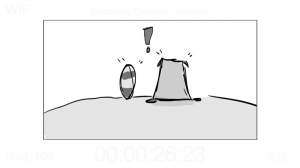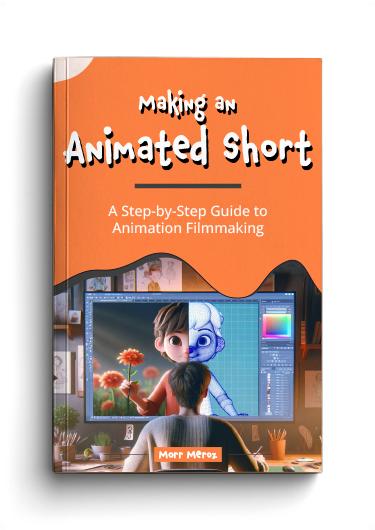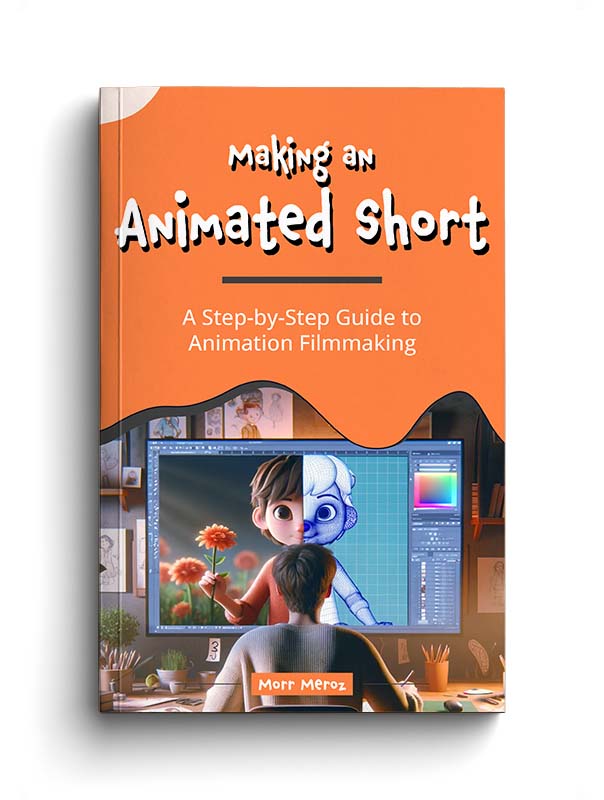Upon graduation there were a few things I wanted: I wanted to be hired by Pixar. I wanted to win awards. I wanted to get hired as a director. I wanted to make movies.
I wanted a lot of things that required other people’s permission. With thousands of you graduating this month, I wanted to share my graduation story, and how I had to pick myself instead of waiting for others to do so.
This is the first time I’m talking about these things in this blog, and I’m doing so because I think it’s important for artists and recent grads (though not exclusively) to hear this. Please read it through till the end, you won’t be sorry.
3 years ago
I graduated in 2013 from the School of Visual arts as a Computer Arts major. My main focus during that last year was to hone my 3D animation skills so that I can get as much work as possible when I graduate, and hopefully even get hired by one of the more famous studios.
I created a short film that focused on my strengths. As an animator, I wasn’t good at most of the technical roles of the 3D pipeline (modeling, rigging, texturing, lighting, rendering etc…), so I created a film about 2 fish with huge heads.
One reason for doing so was that I could stick to 1 environment (a huge aquarium, that only included abstract objects in it) and another reason was that I could focus on the expressions and emotions of my characters. With such large heads, and no legs, fingers or gravity, I could give myself the best chance at getting good performance out of my characters and ended up with a dialogue-focused piece.
No Pixar
I then found out Pixar was coming to our school for a recruiting trip. Their internship program for that year was going to focus on animation, which was amazing news for me since that was my main focus. Also, not many people were into animation in my class so competition was sparse.
I applied for that internship after thoroughly refining my demo reel, and after a few weeks I got the news: I was chosen (along with 2 other students from my class) for a 1-on-1 interview with a Pixar animator who will be visiting our school. That would be as close as I ever got to working at Pixar.
The interview went pretty well, but a few weeks later I found out that I did not get the internship.
That was the first time in my professional life that I realized what’s it like depending on other people’s approval. The feeling of no control. No matter how much I wanted to work for Pixar, if they didn’t agree to have me I couldn’t change it.
No awards
My short film was good. I thought it was was one of the stronger pieces in our class. Being totally objective, of course. Then came the day of announcing which films received the Special Achievement awards. These awards are given to about a dozen students based on reviews and scores from industry professionals who attended the official screening at the SVA theater. While these awards are internal to our school, they are quite significant to the students.
In case you haven’t guessed, I did not receive one of those awards.
That was probably even harder than the Pixar rejection. Pixar, a hugely popular studio, is one thing. But my own school? I hated being so shallow as to give so much significance to awards, but I did.
(P.S – my parents later gave me an award they made for me to make up for it. I did not find it amusing.)
Yet again, I have found myself in a place where other peoples’ approval or permission dictated something in my life. I started to hate that feeling.
One video
One weird thing I did before graduation, and I swear I don’t even remember why exactly I decided to do it, is make a video about how I made that student film. I think I just wanted my friends and family to understand what I do, because they all thought I was a graphic designer.
I got a friend with a video camera and recorded a video going over the different steps of making an animated short film. That video got over 3,000 views over night.
That was way more views than the short film itself got at that time. I thought it was interesting, but I didn’t linger much on it. I had some job offers to go over.
Starting my professional career
While Pixar didn’t go for me, I was still a pretty good applicant. My demo-reel was strong and my award-less film was still pretty cool. I got great internships in some of the best studios in NYC. I enjoyed my time working in the commercial animation industry, but I still remembered that feeling I had of not getting picked.
I knew this could happen at any moment. While I was getting a lot of work for a recent grad, I was still at the mercy of the producers. Some weeks I had no work at all, some weeks I was swamped. I had no control of my day-to-day, and I was constantly waiting.
Waiting
The waiting was the hard part.
Sending resumes, and waiting. Emailing contacts from portfolio-night, and waiting. Filling online applications, and waiting.
There was nothing I could do, they had all the power.
The things I wanted
I looked back at the things I used to want. Out of all those things, I was trying to think which one I can do right now without needing permission from someone else.
I couldn’t force Pixar to hire me.
I couldn’t make anyone give me awards.
I couldn’t get hired as a director, less than a year out of school.
Making more movies? I could do that. I could make another short film.
Making another short film
So I had a mission! Make my second short film. I was really busy, working at studios and navigating my first year as a working professional, but something in me knew that if I wanted to get out of the approval-cycle I had to do my own thing. I had to do something that will give me some control.
But this time I will do things differently. I thought back at that one making-of video I did after my first film, and how it got a lot of attention. I realized people love behind-the-scenes stuff, and that maybe I can use it to get more people interested in my next film.
I decided to document all the process of making that short. I went all in on that. I posted every step and everything I’ve learned. When the storyboard was done I put it up for anyone to download. Not just see how I did it – actually download the file. I wanted no secrecy. I gave it all.
Why did I do all of this? Wouldn’t someone be able to steal my idea? Take my storyboard and make the film themselves? They even had the rigs (I gave them away as well). Why would someone watch a film after they already know the story? Well think about yourself. If you’ve been following a project for a long time, wouldn’t you want to see the final result? Wouldn’t you be much more curious about how it came out than any other animated short that randomly came out at the same time? And regarding copying, I personally don’t believe in “ideas”, but in “execution”. If someone wants to try to redo what I’m doing, go for it. It’ll be a long and unpleasant journey.
I collected all of that content under a website I created. It was Bloop Animation.
Making an Animated Short (FREE ebook)
A free ebook covering the process of making an animated short film from start to finish.
I made a list of my limitations, and tried to work within them, similarly to what I did with the first film, only this time I was even more limited. I was trying to figure out what is the most simple thing I can do, that would still make for a good film.
Like I said, I had no modeling skills. No way I could create complex or even basic characters.
Maya, just like any other 3D program, has what’s called “primitive shapes” from which one can start modeling. Cubes, spheres, planes, torus etc. I thought – What if I took the 2 most basic shapes Maya has, a cube and a sphere, and have them as my main characters?

I know what you’re thinking. Only a cube and a ball?? The answer is… Yes.
As I kept working on my film, I kept sharing. My reason for sharing so much of how I did things is that I believed (and still do) that the more you included people in your process the more you make them care about the finished product. About the film.
I was happy. I had a secret plan. A “thing” I was doing on the side. I was working all day at a studio, then writing articles/recording tutorials at nights and weekends. I had a purpose, and I stopped caring about getting picked. I already chose myself.
In the summer of 2014, my short film about a cube and a ball, LIFT UP, was released.
Writing a book
By the time LIFT UP was released I have accumulated quite a bit of content on my blog and YouTube channel. Although I initially created the website as a place to talk about my film, I realized it has built a rather large audience, and many of the readers were interested in becoming animators as well, and a lot of them didn’t know the first thing about where to get started.
When looking at all the written content I had on my site, and the people enjoying it, I asked myself Why not write a book for those people? For beginners?
Who the hell are you to write a book?
That was the first question that came to me (as well as for others who’ve heard about this idea, I’m sure). I was less than a year out of school and I was going to write a book about animation? Who’s going to let me do that?
Well, that’s the cool thing about not needing permission anymore. Choosing myself, remember?
While I wasn’t an animation expert, I did know more about getting into the animation industry, about the path of becoming an animator, or about filmmaking, than someone who’s only thinking about getting into animation. High school students trying to pick a school, or someone looking for a change in careers. Someone who’s a total beginner to animation.
So I wrote Animation For Beginners. A book that teaches everything you need to know about getting into the world of animation. I didn’t have a publisher. I published it on my own site.
That book has sold thousands of copies and was an Amazon #1 best-seller under animation for a while. If I had waited for someone else to give me permission to write a book, like using a publisher, there’s no way I would have gotten a book deal.
Today
Since that one video, Bloop Animation has turned into an actual business, allowing me to work on my own projects full-time. I’m currently working on my third film, leading a team of 15 artists from around the world. We’ve released another book, Pixar Storytelling which also become a #1 Amazon best-seller, and we have an animation course for almost every animation software.
I no longer wait for others to pick me, nor do I ask them to. I worked hard to create freedom for myself, and even though this is not at all what I imagined would happen after graduation, I’m happy it did.
Graduating
When you graduate this month you might feel like you’re no longer in control of your own destiny. Like you’re just waiting for the email to ring, for someone to choose you. Always remember that there is something you can do. I’m not suggesting that everyone should start a YouTube channel and write books, but I am saying that there is something unique and creative that you can do to push yourself forward.
Are you a modeler? Show a step-by-step video of how you modeled a character. Share your process and how you solved certain problems. Make a case study out of it. People think you know what you’re doing when you share how you did it. You can do it for every type of work. Not comfortable with videos? Write about it. Keep a blog, a tumbler, a Facebook group. Keep making stuff and sharing them until someone hires you, and then when they do hire you, keep making stuff.
Even if you’re in the business of waiting to get picked, as so many of you will be, try to find a way to pick yourself.




